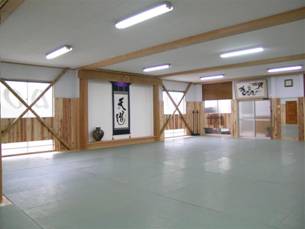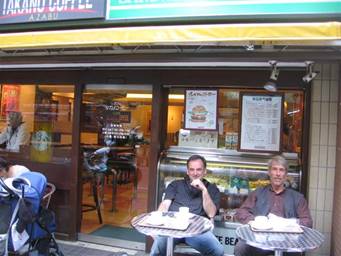Training at the Tendokan
The Tendokan, the main Dojo of Tendoryu Aikido in Tokyo/Japan is located next to Sangenjaya station of the Shintamagawa line (it is the second station from Shibuya to Futako-Tamagawa; however, it is the first station for the Kyuko express train, which only stops at few stations), or rather Hanzomon line, how it is called until Shibuya station. By the way, this strange line runs as a subway inside the city but otherwise as a normal train far outside of Tokyo in Southern and Northern direction.
After three minutes walking along the Highway 246, which is crowded 24 hours a day, you will notice already on the left side the double-storied building with the ‘Tendoryu Aikido’ sign on top. At the ground floor is a Spartan Kendo/Karate/Iaido hall, the Tendokan is located at the first floor, and at the second floor four parties are living in two-room apartments (probably all hard of hearing).
The Tendokan has about 100 square meter Tatami (refer to picture below; at the right side at the end there are changing rooms and showers, at the right side Dogis and Hakamas are hanging from the ceiling).

It was the first visit at the Tendokan for C and the first visit for P after the renovation. The new ceiling and the light-colored wooden walls make the Dojo even more comfortable and friendlier. Unfortunately the environment of the Tendokan building is crammed more and more with new buildings everywhere because of the precarious room problems in Greater Tokyo.
Except on Monday (the only day off) students practice up to two hours in the morning (starting at 6:30am) and up to three hours in the evening (starting at 6:00pm) with 45 minutes time per unit. So presently within a week there are 20 classes for adults.
In general students from abroad attend most classes as they have during their stay in Japan less job-related or family-related restrictions as the locals. The 45 minutes classes spin away, however sometimes you will be stressed a little by three consecutive classes – especially during the hot tropical season.
We tramped to the Tendokan about 25 minutes along the high way 246 (which runs on pillars in about 25m height along the general main road and leaves town in south-west direction). Alternatively we could have boarded the subway (the Shintamagawa line coming from Shibuya), which runs also parallel, at the station Ikejiri-Ohashi (the station before our destination Sangenjaya), but that was also a walk of about 10 minutes. We did not use the various buss lines running as well parallel to the high way, because we couldn’t spot any busses early in the morning on our way to the Tendokan morning classes. Maybe the busses only started from 6am. Therefore we carefully had to consider the walking time when going to the Dojo, i.e. because of morning classes the clock rung at 5:15am three times a week.
The way home was somehow more relaxing but exciting as well as we came across various vending machines, which only waited to spit out their ice-cold loading of various soft drinks for little money (66 cent for a half liter) to prevent the thirsty wanderers of breakdown.
Most of the participants – and especially the students from abroad – were in the Dojo already 20-25 minutes before start of practice, fetched their Dogi and Hakama from the clothes rail at the ceiling (Dogis and Hakamas may be stored in the Dojo, as most Japanese come directly from the office or are on they way to the office after morning classes), and disappeared in the changing rooms. The over and over upcoming hope that the Dogi pressed with other Dogis at the rail, which were soaked with sweat from the day before, would have dried and be odorless, always remained an illusion.
10 minutes before practice started most of the normally 20-25 participants were on the Tatami, because Shimizu Sensei or another trainer came out of the Tendokan office at about the same time. A light warming-up before practice is advisable, but it should not disturb the meditative mood of the non warming-up folks by too intense or even noisy movements. Jogging around in the Dojo is a ‘never’ – also because lack of space.
After a short meditation or concentration in Seiza in a line all bowed to the Tendo sign at the Tokonoma (sacred location in the Dojo), and the training began. By the way, there is no picture of O-Sensei in the Dojo.
The techniques are – of course – the same as at the seminars in foreign countries, but there is less forward Ukemi and much less somersaulting, as normally there are too many students. It was quite something special, if there were fewer students and the techniques could be performed in the same way as at seminars in Europe.
Generally during a 45 minutes class three techniques were demonstrated and practiced. Frequently Shimizu Sensei teaches about the spirit of Aikido and about his experiences in foreign countries. Trainers besides Shimizu Sensei are presently Watanabe Sensei (6. Dan), Nagai Sensei (5. Dan), Takahashi Sensei (4. Dan), Sato Sensei and Waka Sensei (3. Dan). If Shimizu Sensei is present in the Dojo he normally teaches. If not the other trainers take turns. The methods of teaching are a little different, but most of the trainers try to practice as well when teaching, if there are not too many students.
Most of the Japanese Aikidoka practice a little more flexible and softer as foreigners are used to, and that is very enjoyable. There are of course exceptions; sometimes you come across stiffer Japanese partners or new students with a different Aikido specific history as well. During the training the Aikidoka do not talk at all; the techniques are studied and practiced but not discussed. Shouting or noisy breathing out is not common. Advanced students or one of the trainers take intensively care for new students during the first weeks, before they will be efficiently integrated into the group. New and advanced students from 14 years up to high age practice jointly. However, since about six month ago additional training for dan degree holders is provided once a month (Friday, third class).
After every (!) class the Tatamis are cleaned wetly, everybody rushes through the Dojo on knees with a piece of rag (which after cleaning will be thrown into the washing machine to be fit for the next cleaning round). Those who did not succeed in getting a free Tatami area for cleaning will polish window frames or furniture – sometimes several times, because nobody will stand around inactively while everybody else is busy. It is said that there are special regulations for students above 60 years, but I did not spot anybody, whom I would place into this group, acting against group pressure.
After cleaning a short break, rearranging of clothes, and then the next round follows. After the third class (and after the third evening cleaning procedure) the Dojo is available for some time for free practice.
After practice we dragged on exhaustedly with last efforts to the next vending machine and regained an upright posture after first soft drinks.
After the morning class often we visited our breakfast cafe (we tried several in the beginning), where we ordered coffee (or tea), two delicious sandwiches (with eggs, tuna fish, salad) and a little salad dish for about 3 Euro. With every weather conditions we sat outside and watched the passing locals (they are always rushing!). What is after practice even better than a well-earned breakfast? Two breakfasts?!

Excellent trainers, many classes, good partners, a enjoyable atmosphere in the Dojo – still thinking about the next holiday destination for a keen Aikidoka?
C&P